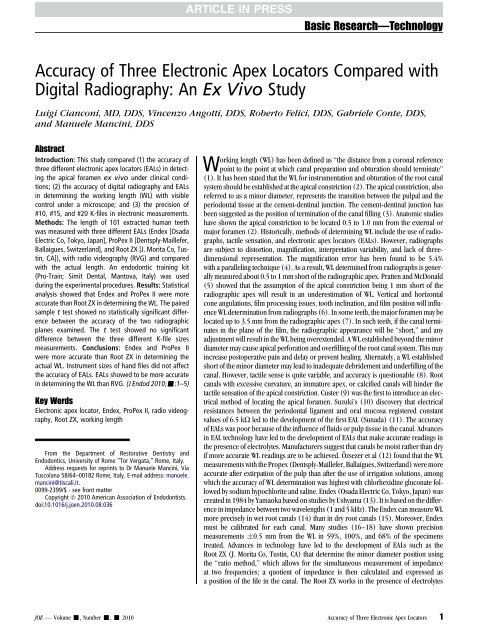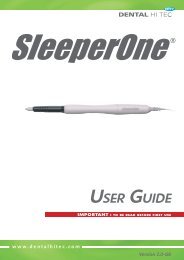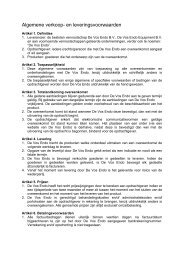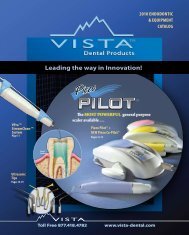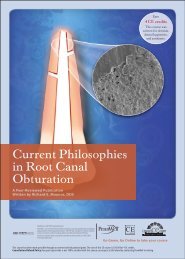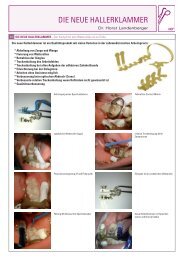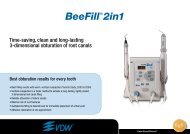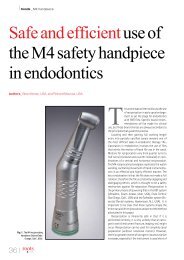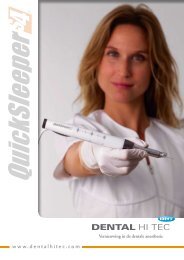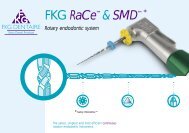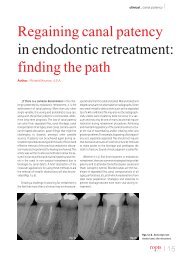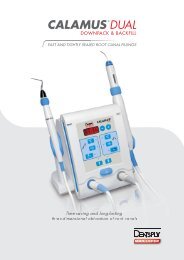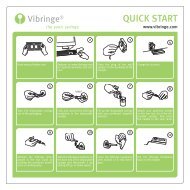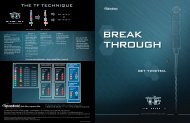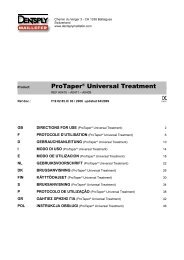Accuracy of Three Electronic Apex Locators ... - De Vos Endo BV
Accuracy of Three Electronic Apex Locators ... - De Vos Endo BV
Accuracy of Three Electronic Apex Locators ... - De Vos Endo BV
- No tags were found...
You also want an ePaper? Increase the reach of your titles
YUMPU automatically turns print PDFs into web optimized ePapers that Google loves.
Basic Research—Technology<strong>Accuracy</strong> <strong>of</strong> <strong>Three</strong> <strong>Electronic</strong> <strong>Apex</strong> <strong>Locators</strong> Compared withDigital Radiography: An Ex Vivo StudyLuigi Cianconi, MD, DDS, Vincenzo Angotti, DDS, Roberto Felici, DDS, Gabriele Conte, DDS,and Manuele Mancini, DDSAbstractIntroduction: This study compared (1) the accuracy <strong>of</strong>three different electronic apex locators (EALs) in detectingthe apical foramen ex vivo under clinical conditions;(2) the accuracy <strong>of</strong> digital radiography and EALsin determining the working length (WL) with visiblecontrol under a microscope; and (3) the precision <strong>of</strong>#10, #15, and #20 K-files in electronic measurements.Methods: The length <strong>of</strong> 101 extracted human teethwas measured with three different EALs (Endex [OsadaElectric Co, Tokyo, Japan], ProPex II [<strong>De</strong>ntsply-Maillefer,Ballaigues, Switzerland], and Root ZX [J. Morita Co, Tustin,CA]), with radio videography (RVG) and comparedwith the actual length. An endodontic training kit(Pro-Train; Simit <strong>De</strong>ntal, Mantova, Italy) was usedduring the experimental procedures. Results: Statisticalanalysis showed that Endex and ProPex II were moreaccurate than Root ZX in determining the WL. The pairedsample t test showed no statistically significant differencebetween the accuracy <strong>of</strong> the two radiographicplanes examined. The t test showed no significantdifference between the three different K-file sizesmeasurements. Conclusions: Endex and ProPex IIwere more accurate than Root ZX in determining theactual WL. Instrument sizes <strong>of</strong> hand files did not affectthe accuracy <strong>of</strong> EALs. EALs showed to be more accuratein determining the WL than RVG. (J <strong>Endo</strong>d 2010;-:1–5)Key Words<strong>Electronic</strong> apex locator, Endex, ProPex II, radio videography,Root ZX, working lengthFrom the <strong>De</strong>partment <strong>of</strong> Restorative <strong>De</strong>ntistry and<strong>Endo</strong>dontics, University <strong>of</strong> Rome ‘‘Tor Vergata,’’ Rome, Italy.Address requests for reprints to Dr Manuele Mancini, ViaTuscolana 58/64–00182 Rome, Italy. E-mail address: manuele.mancini@tiscali.it.0099-2399/$ - see front matterCopyright ª 2010 American Association <strong>of</strong> <strong>Endo</strong>dontists.doi:10.1016/j.joen.2010.08.036Working length (WL) has been defined as ‘‘the distance from a coronal referencepoint to the point at which canal preparation and obturation should terminate’’(1). It has been stated that the WL for instrumentation and obturation <strong>of</strong> the root canalsystem should be established at the apical constriction (2). The apical constriction, alsoreferred to as a minor diameter, represents the transition between the pulpal and theperiodontal tissue at the cement-dentinal junction. The cement-dentinal junction hasbeen suggested as the position <strong>of</strong> termination <strong>of</strong> the canal filling (3). Anatomic studieshave shown the apical constriction to be located 0.5 to 1.0 mm from the external ormajor foramen (2). Historically, methods <strong>of</strong> determining WL include the use <strong>of</strong> radiographs,tactile sensation, and electronic apex locators (EALs). However, radiographsare subject to distortion, magnification, interpretation variability, and lack <strong>of</strong> threedimensionalrepresentation. The magnification error has been found to be 5.4%with a paralleling technique (4). As a result, WL determined from radiographs is generallymeasured about 0.5 to 1 mm short <strong>of</strong> the radiographic apex. Pratten and McDonald(5) showed that the assumption <strong>of</strong> the apical constriction being 1 mm short <strong>of</strong> theradiographic apex will result in an underestimation <strong>of</strong> WL. Vertical and horizontalcone angulations, film processing issues, tooth inclination, and film position will influenceWL determination from radiographs (6). In some teeth, the major foramen may belocated up to 3.5 mm from the radiographic apex (7). In such teeth, if the canal terminatesin the plane <strong>of</strong> the film, the radiographic appearance will be ‘‘short,’’ and anyadjustment will result in the WL being overextended. A WL established beyond the minordiameter may cause apical perforation and overfilling <strong>of</strong> the root canal system. This mayincrease postoperative pain and delay or prevent healing. Alternately, a WL establishedshort <strong>of</strong> the minor diameter may lead to inadequate debridement and underfilling <strong>of</strong> thecanal. However, tactile sense is quite variable, and accuracy is questionable (8). Rootcanals with excessive curvature, an immature apex, or calcified canals will hinder thetactile sensation <strong>of</strong> the apical constriction. Custer (9) was the first to introduce an electricalmethod <strong>of</strong> locating the apical foramen. Suzuki’s (10) discovery that electricalresistances between the periodontal ligament and oral mucosa registered constantvalues <strong>of</strong> 6.5 kU led to the development <strong>of</strong> the first EAL (Sunada) (11). The accuracy<strong>of</strong> EALs was poor because <strong>of</strong> the influence <strong>of</strong> fluids or pulp tissue in the canal. Advancesin EAL technology have led to the development <strong>of</strong> EALs that make accurate readings inthe presence <strong>of</strong> electrolytes. Manufacturers suggest that canals be moist rather than dryif more accurate WL readings are to be achieved. Özsezer et al (12) found that the WLmeasurements with the Propex (<strong>De</strong>ntsply-Maillefer, Ballaigues, Switzerland) were moreaccurate after extirpation <strong>of</strong> the pulp than after the use <strong>of</strong> irrigation solutions, amongwhich the accuracy <strong>of</strong> WL determination was highest with chlorhexidine gluconate followedby sodium hypochlorite and saline. Endex (Osada Electric Co, Tokyo, Japan) wascreated in 1984 by Yamaoka based on studies by Ushyama (13). It is based on the differencein impedance between two wavelengths (1 and 5 kHz). The Endex can measure WLmore precisely in wet root canals (14) than in dry root canals (15). Moreover, Endexmust be calibrated for each canal. Many studies (16–18) have shown precisionmeasurements 0.5 mm from the WL in 59%, 100%, and 68% <strong>of</strong> the specimenstreated. Advances in technology have led to the development <strong>of</strong> EALs such as theRoot ZX (J. Morita Co, Tustin, CA) that determine the minor diameter position usingthe ‘‘ratio method,’’ which allows for the simultaneous measurement <strong>of</strong> impedanceat two frequencies; a quotient <strong>of</strong> impedance is then calculated and expressed asa position <strong>of</strong> the file in the canal. The Root ZX works in the presence <strong>of</strong> electrolytesJOE — Volume -, Number -, - 2010 <strong>Accuracy</strong> <strong>of</strong> <strong>Three</strong> <strong>Electronic</strong> <strong>Apex</strong> <strong>Locators</strong> 1
Basic Research—Technologyand nonelectrolytes and requiresno calibration (19). In vivo studies haveshown the Root ZX to be accurate in locating the minor diameter to within1mm(20–23). Recently, a new EAL, the ProPex II, has been developed(<strong>De</strong>ntsply-Maillefer). It measures with multisignal frequencies the energy<strong>of</strong> the signal, not the amplitude as for all EALs.The purpose <strong>of</strong> this study was three-fold: (1) to compare the accuracy<strong>of</strong> Endex, Root ZX, and ProPex II in detecting the apical foramen exvivo under clinical conditions; (2) to compare the accuracy <strong>of</strong> digitalradiography and EALs in determining the WL, with visible control undera microscope; and (3) to compare the precision <strong>of</strong> #10, #15, and #20K-files in electronic measurements.Materials and MethodsWe selected 101 periodontally involved human teeth extractedfrom 35- to 60-year-old patients, with the approval <strong>of</strong> the Ethics inResearch Committee <strong>of</strong> the Centre <strong>of</strong> Health Sciences <strong>of</strong> the University<strong>of</strong> Rome ‘‘Tor Vergata.’’ After being cleaned, each root was carefullyexamined by stereomicroscopy (Universal-300; Moeller-Wedel, Wedel,Germany) at 20 magnification for the detection <strong>of</strong> the presence <strong>of</strong>external cracks, wide-open apices, or apices undergoing resorption,which might alter the accuracy <strong>of</strong> the WL measurements. The teethwere devoid <strong>of</strong> caries, endodontic treatments, or restorations. Afterextraction, teeth were stored in 2% thymol solution at room temperatureand used within 1 week. Each crown was sectioned at midlevelby means <strong>of</strong> a crosscut carbide bur (<strong>De</strong>ntsply-Maillefer) in a highspeedhandpiece with water spray to produce a flat surface for theprecise location <strong>of</strong> the rubber stop. <strong>Endo</strong>dontic access to the pulpchamber was gained with a round diamond-coated bur (<strong>De</strong>ntsply-Maillefer).Pulp canal debris was removed from the coronal third <strong>of</strong> thecanal with a #4 Gates-Glidden bur. After each canal was identified, threedifferent K-files (#06, #08, and #10; <strong>De</strong>ntsply-Maillefer) were passedthrough the apex to verify canal patency. Excess fluid was removedfrom the pulp chamber, but no attempt was made to dry the canal.The specimens were placed in a tooth holder, which is part <strong>of</strong> anendodontic training kit (Pro-Train; Simit <strong>De</strong>ntal, Mantova, Italy)(Fig. 1). The conducting medium was an ecoelectroconductive gel(Farmacare Srl, Casale, Italy). The gel was poured into the box beforethe specimen was inserted into the endodontic training kit. The specimenwas tightly held inside the tooth holder in the lid <strong>of</strong> the Pro-Trainto prevent displacement during measurements.EAL MeasurementsWe used three different K-files (#10, #15, and #20) with a siliconestop to make multiple electronically determined WL readings in eachcanal using the three EALs. Because three EALs were used with eachcanal, we alternated the first EAL to be used in each successive canal.After recording the WL with the first EAL, we withdrew the #10 fileand measured with a digital caliper (Mitutoyo 571-202-20; MitutoyoItaliana SRL, Linate, Italy), which was recorded to the nearest 0.5mm. After recording the WL, we reinserted the same file to determinethe WL using the second and third EALs and measuring in the samemanner. The same procedure was repeated for each specimen withthe K-files #15 and #20. For each specimen, we obtained nine electronicmeasures (three for each K-file). To reduce variables, only one calibratedoperator carried out the electronic readings with endpoints indicated.For the Endex, the file was advanced until the analog numeric barread 0.0 within the red interval. For the Root ZX, the file was advanceduntil the liquid crystal display indicated the flashing word ‘‘APEX.’’ Forthe ProPex II, the file was advanced until the liquid crystal display indicatedthe flashing word ‘‘APEX’’ and ‘‘0.0,’’ indicating the location <strong>of</strong> theforamen (according to the manufacturer’s instructions).Digital Radiography MeasurementsWe used average electronic measurements to take radiographs.We used the K-file that showed the mean <strong>of</strong> measurements closest tothe average <strong>of</strong> the nine electronic measurements taken for each specimen.If the three files showed the same electronic measurementmean, we used the largest. We made radiographic measurementswith a 0 inclination in both the mesiodistal and buccolingual planesusing the Pro-Train radio videography sensor holders and a custombase where Pro-Train, an RVG sensor (DSX Digital Sensor; Anthos ImpiantiSRL, Imola, Italy), a radiographic tube (Evolution X 3000; NewLife Technology SRL, Grugliasco, Italy), and specimens were firmlyblocked and collimated (Fig. 2). The distance from the end <strong>of</strong> thefile and the radiographic apex was measured (Image Easy Managing,Anthos Impianti SRL) and recorded. A consensus in the measurementswas always reached among three investigators after examining 20 specimensjointly for calibration purposes. Intra- and interexaminer reliabilityfor RVG assessment was verified by the Kappa test.Actual WL MeasurementsAfter the RVG analysis, we removed the specimen from the socket<strong>of</strong> the Pro-Train, ensuring that it had not been displaced during the electronicand RVG measurements. We measured the root length (actualWL) using the same K-file used for the RVG measurement. UsingFigure 1. Pro-Train and its components.Figure 2. Experimental apparatus during radiographic measurements.2 Cianconi et al. JOE — Volume -, Number -, - 2010
TABLE 1. Statistical Analysis on the <strong>Accuracy</strong> <strong>of</strong> EALs and the Actual Working Length (mm)Mean Standard <strong>De</strong>viation Minimum Maximum t Value Pr >[t]ENDEX (n = 101) 0.23 0.34 0.5* 1 7.03 p < 0.001ROOT ZX (n = 98) 0.50 0.42 0.17* 1.67 11.88 p < 0.001PROPEX II (n = 101) 0.27 0.37 0.67* 1.5 7.49 p < 0.001EAL, electronic apex locator.*Negative values indicate that the K-file’s tip is inside the root canal.Basic Research—Technologya microscope at 5 magnification (Carl Zeiss GmbH, Oberkochen,Germany), we inserted the K-file with a silicone stop into the root untilits tip was observed at the level <strong>of</strong> the most coronal border <strong>of</strong> the apicalforamen. When the file tip was observed at the apical foramen, the stopwas stabilized at the coronal edge <strong>of</strong> the tooth, the file was removed, andthe distance between the stop and the file tip was measured with a digitalcaliper. Blind evaluation was performed independently by threeobservers after examining 20 specimens jointly for calibrationpurposes. Intra- and interexaminer reliability for actual WL assessmentwas verified by the Kappa test. We recorded a mean value <strong>of</strong> actual WLmeasurements for each tooth and subjected it to statistical analysis bythe paired t test to compare the numbers <strong>of</strong> teeth with precise measurementsfor each apex locator. We also used the paired t test to comparethe measurements <strong>of</strong> the apex locators for each tooth because the sameteeth were used. We used the same statistical analysis to determine theaccuracy <strong>of</strong> the radiographic method and to compare the accuracy <strong>of</strong>the 3 K-files.ResultsKappa test results, with a significance set at 0.5, showed goodintra- and interexaminer agreement, with values ranging from 0.90and above for the different groups. EAL accuracy values are shown inTable 1. Endex and ProPex II were more accurate than Root ZX in determiningthe WL. The mean differences between EAL WL measurementsand actual WL (Endex, Root ZX, and ProPex II) were 0.23 mm, 0.50mm, and 0.27 mm, respectively. The apical foramen (0.5 mm) wasdetermined in 84.1%, 62.4%, and 82.2% <strong>of</strong> the specimens for Endex,Root ZX, and ProPex II, respectively. All EALs showed the followingsignificant tendency toward overestimation: 15.9%, 37.6%, and17.8%, respectively, for Endex, Root ZX, and ProPex II. No measureswere underestimated. The radiographic position <strong>of</strong> the file’s tip wasconsistent with the apical foramen in 44.5% and 51.5% <strong>of</strong> the specimensin the buccolingual and mesiodistal planes, respectively, witha significant tendency toward underestimation. The mean distancesbetween the file tip and the radiographic apex were 0.02 mm(0.42) and 0.05 mm (0.39), respectively, for the buccolingualand the mesiodistal planes (Table 2). No electronic measurementswere influenced by the three different instrument sizes <strong>of</strong> hand files.Statistical AnalysisWe used a paired sample t test to compare the results and determineda significant difference at a 99.9% confidence level. The analysiswas performed with the SAS System (SAS Institute SRL, Milan, Italy).Statistical analysis showed a significant difference between Root ZX(p < 0.001) and both ProPex II and Endex measurements. Therewas no statistically significant difference between ProPex II and Endex.The t test showed no statistically significant difference between theaccuracy <strong>of</strong> the two radiographic planes examined. The t test showedno significant difference between the three different sizes <strong>of</strong> K-files.DiscussionNumerous studies have reported on the accuracy <strong>of</strong> EALs for determiningthe location <strong>of</strong> the minor diameter (21, 22, 24). EALs canaccurately determine the WL in 75.0% to 96.5% <strong>of</strong> the root canalswith mature apices (25–27). These studies differ in establishing thereference point from which measurement accuracy is determined.Some authors measured from the minor diameter (apicalconstriction) (21, 22, 27–33), whereas others measured from themajor diameter or apical foramen (16, 23, 34). EALs havetraditionally afforded some latitude <strong>of</strong> acceptable error in locating theapex (21, 25, 26, 30). As a result, different ranges have been used inthe evaluation <strong>of</strong> EAL accuracy. Diverse studies have usuallyconsidered the electronic measurements for the minor constrictionto be between the 0.5-mm mark (16, 20, 21, 28–30, 32, 33, 35,36), which is considered highly accurate (37), and the 1-mm mark(24, 36, 38–40). One reason cited for accepting a 1.0-mm margin <strong>of</strong>error is the wide range seen in the shape <strong>of</strong> the apical third (21,41). Thus, this variation is clinically acceptable (21) because microscopicstudies revealed that this landmark might be positioned withinthis range (2, 41, 42). Nevertheless, whatever the apical limit, themeasuring device used should be precise and reliable (ie, able tolocate the chosen limit and giving similar readings when used bymore than one operator [37]). The materials most <strong>of</strong>ten used are alginate(28, 31, 32, 35, 40), agar (36, 43), saline solution (24, 27), andgelatin (44). The validity <strong>of</strong> measurements made with in vitro models(ie, the extent to which they depict the clinical accuracy <strong>of</strong> EALs) isunknown (36). However, they are able to reproduce the clinical condition<strong>of</strong> EAL use and facilitate the objective examination <strong>of</strong> severalTABLE 2. Statistical Analysis on the <strong>Accuracy</strong> <strong>of</strong> EALs and RVG System Measurements (mm)Buccolingual Plane Mean Standard <strong>De</strong>viation Minimum Maximum t Value Pr > [t]ENDEX (n = 99) 17.27 2.24 12.1 21.6 76.48 p < 0.001ROOT ZX (n = 96) 17.40 2.25 12.1 22.07 75.78 p < 0.001PROPEX II (n = 99) 17.25 2.29 12.1 21.6 74.89 p < 0.001Mesiodistal Plane Mean Standard <strong>De</strong>viation Minimum Maximum t Value Pr > [t]ENDEX (n = 101) 17.19 2.20 12.1 21.5 78.32 p < 0.001ROOT ZX (n = 98) 17.36 2.20 12.1 22.07 77.99 p < 0.001PROPEX II (n = 101) 17.22 2.26 12.1 21.5 76.57 p < 0.001EAL, electronic apex locator; RVG, radio videography.JOE — Volume -, Number -, - 2010 <strong>Accuracy</strong> <strong>of</strong> <strong>Three</strong> <strong>Electronic</strong> <strong>Apex</strong> <strong>Locators</strong> 3
Basic Research—TechnologyTABLE 3. Resistance Values (kU) <strong>of</strong> Alginate Mixed with <strong>De</strong>ionized Water orTap Water and the Ecoelectroconductive GelT = 0 min T = 1 min T = 5 minAlginate with20 KU 415 KU 1035 KUdeionized waterAlginate with tap 15 KU 220 KU 843 KUwaterGel 255 KU 255 KU 255 KUvariables that is not practical in in vivo studies (36, 43). It has beensuggested that EALs operate on the principle <strong>of</strong> electricity rather thanthe biological properties <strong>of</strong> the tissues involved (45). Therefore, modelsin which extracted teeth are immersed in media with electrical resistancesimilar to that <strong>of</strong> the periodontal tissue can give precise and reliableinformation on their function (43). In the current study, anecoelectroconductive gel was used as a medium because <strong>of</strong> its suitableelectroconductive property. The resistance <strong>of</strong> alginate mixed with deionizedwater or tap water and the ecoelectroconductive gel was tested(Table 3). Results showed that gel was stable with time and not influencedby room temperature and humidity compared with both alginatemixtures. In fact, 5 minutes from the end <strong>of</strong> mixing, alginate resistivitywas increased 10-fold compared with the first minute after mixing andfive-fold higher than gel. ProTrain and gel poured into a dedicated boxconstitute an effective tool for the evaluation <strong>of</strong> EALs and familiarize theoperator with electronic root canal length measurement because <strong>of</strong> itshigh degree <strong>of</strong> stability, low cost, and simplicity <strong>of</strong> execution. Furthermore,the roots clamped by the ProTrain holder are sufficiently stronglyheld to resist the force exerted by experimental procedures. It alsoallows for the roots to be hidden, making it possible for measurementsto be made objectively with minimum bias. We did not use NaOClthroughout the study to avoid denaturing root dentin during repeatedmeasurements on the same specimens; therefore, we used NaOClinitially to help eliminate root canal debris but not thereafter. In thecurrent study, to reduce variables according to the operator’s manual,only one calibrated operator carried out the electronic readings, whichwas essential to obtaining precise and consistent results. In this study,the mean distance beyond the minor diameter was 0.3 mm, with a range<strong>of</strong> 0.5 mm to 1 mm. Different ex vivo methods have been used toinvestigate the accuracy <strong>of</strong> EALs. One is shaving the apical portion <strong>of</strong>the root along the long axis <strong>of</strong> the tooth in a plane determined toshow the best representation <strong>of</strong> the minor diameter in relation to thefile. If the apical portion is not shaved, the relationship between thefile tip and the constriction cannot be established. In the current study,this method was not used because the choice <strong>of</strong> the ‘‘APEX’’ mark on thedisplay led to the use <strong>of</strong> the apical foramen as a landmark, rendering theshaving <strong>of</strong> the apical portion <strong>of</strong> the root unnecessary. To compare EALaccuracy, we also used radiographic analysis. A problem with radiographiccomparisons in vivo is that the anatomic foramen can belocated anywhere from 0.0 to 3.0 mm from the radiographic apex(2). Pineda and Kuttler (46) reported the foramen to be locatedaway from the anatomic apex in 83% <strong>of</strong> teeth examined. Because conditionssimilar to those in the clinic would not be as ideal because <strong>of</strong>magnification errors and overestimation <strong>of</strong> canal length, in this study28.5% <strong>of</strong> the teeth appearing radiographically acceptable actually hadthe file tip beyond the foramen. The results <strong>of</strong> this study are in agreementwith those <strong>of</strong> previous studies in which 15 <strong>of</strong> the 22 files(68.2%) that appeared on buccolingual projection to be at or short<strong>of</strong> the radiographic apex actually had the file tip beyond the desiredWL. These results are in agreement with those <strong>of</strong> other studies (20).In vitro, EALs were 10% to 40% more accurate than radiographs inlocating the minor diameter (5, 18). Also <strong>of</strong> interest was the relativesize <strong>of</strong> the file compared with the diameter <strong>of</strong> the apical endpoint.Manufacturers <strong>of</strong> EALs recommend using the largest file that registersa WL reading. Briseño-Marroquin et al (47) studied the accuracy <strong>of</strong>four different EALs with three different instrument sizes <strong>of</strong> hand files.They found that sizes #08, #10, and #15 had no influence on the accuracy<strong>of</strong> WL determination in agreement with our results. In vitro studieshave shown the Root ZX to be 62.7% to 68% accurate to within 0.5 mmand 90% to 97.5% accurate to within 1 mm <strong>of</strong> the minor diameter (18,24, 48). The accuracy <strong>of</strong> the Endex, ProPex II, and Root ZX in locatingthe apical foramen within 0.5 mm was 86.1%, 83.2%, and 65.3%,respectively, with mean distances <strong>of</strong> 0.31, 0.45, and 0.57 mm,respectively, past the minor diameter. Siu et al (49) showed in anin vitro study that the mean distance to the minor diameter was between0.16 and 0.22 mm. Lucena-Martin et al (35), testing the in vitro accuracy<strong>of</strong> 3 EALs in vitro, showed that in 5% <strong>of</strong> the canals the measurementssurpassed the apical foramen. These results are in agreementwith those <strong>of</strong> the present study in which the file tip was beyond the apicalforamen in 51.4% <strong>of</strong> the canals when the ‘‘APEX’’ mark on the dial wasused. This fact must be seriously considered because in clinical conditions,in contrast to in vitro studies, a greater variation in measurementsis expected because the favorable circumstances for precisemeasurements are not available (39), and, consequently, an overestimatedWL could lead to a poor prognosis (50). These findings raisethe question <strong>of</strong> whether the WL should be established at the point wherethe EAL indicates the apical foramen or at some distance coronal to thatpoint (33). Mayeda et al (51) suggest that ‘‘each operator should correlatehis own radiographic and clinical findings with the analog dial readingson the instrument to determine exactly where on the dial theoperator wants to call his apex.’’ In this way, some authors haveproposed withdrawing the instrument 0.5 or 1 mm when using theRoot ZX with the display meter setting at ‘‘0.5’’ to ensure that the filetip does not protrude beyond the apical constriction, avoiding rootcanal overpreparation (23, 30).ConclusionsBased on the results <strong>of</strong> the present study, to prevent overestimation<strong>of</strong> the root canal length using the three different EALs tested, 1 mmshould be subtracted from the measurement on the ‘‘APEX’’ mark.EALs have shown to be more precise than digital radiography in detectingthe apical foramen. <strong>Electronic</strong> measurements were not influencedby instrument sizes <strong>of</strong> hand files.AcknowledgmentWe would like to thank Dr Marco Costantini from the ChiesiGroup SpA (Parma, Italy) for assisting with the statistical analysis.References1. Glossary <strong>of</strong> <strong>Endo</strong>dontic Terms. 7th ed. Chicago, IL: American Association <strong>of</strong><strong>Endo</strong>dontists; 2003.2. Kuttler Y. Microscopic investigation <strong>of</strong> root apexes. J Am <strong>De</strong>nt Assoc 1955;50:544–52.3. Grove CJ. A new simple standardized technique producing perfect fitting impermeableroot canal fillings extended to the dento-cemento junction. <strong>De</strong>nt Items Interest1928;50:855–7.4. Vande Voorde HE, Bjorndahl AM. Estimating endodontic ’’working length‘‘ with parallelingradiographs. Oral Surg Oral Med Oral Pathol Oral Radiol <strong>Endo</strong>d 1969;27:106–10.5. Pratten DH, McDonald NJ. Comparison <strong>of</strong> radiographic and electronic workinglengths. J <strong>Endo</strong>d 1996;22:173–6.6. Goldman M, Pearson AH, Darzenta N. <strong>Endo</strong>dontic success: who’s reading the radiograph?Oral Surg Oral Med Oral Pathol Oral Radiol <strong>Endo</strong>d 1972;33:432–7.4 Cianconi et al. JOE — Volume -, Number -, - 2010
Basic Research—Technology7. Green DA. Stereo binocular microscopic study <strong>of</strong> the root apices and surroundingareas <strong>of</strong> 100 mandibular molars. Oral Surg Oral Med Oral Pathol Oral Radiol <strong>Endo</strong>d1955;8:1298.8. Seidberg BH, Alibrandi <strong>BV</strong>, Fine H, et al. Clinical investigation <strong>of</strong> measuring workinglengths <strong>of</strong> root canals with an electronic device and with digital-tactile sense. J Am<strong>De</strong>nt Assoc 1975;90:379–87.9. Custer LE. Exact methods <strong>of</strong> locating the apical foramen. Q Natl <strong>De</strong>nt Assoc 1918;5:815–9.10. Suzuki K. Experimental study on iontophoresis. J Jap Stomatol 1942;16:411.11. Sunada I. New method for measuring the length <strong>of</strong> the root canal. J <strong>De</strong>nt Res 1962;41:375–87.12. Özsezer E, Inan U, Aydin U. In vivo evaluation <strong>of</strong> ProPex electronic apex locator.J <strong>Endo</strong>d 2008;33:974–7.13. Ushiyama J. New principle and method for measuring the root canal length. J <strong>Endo</strong>d1983;9:97–104.14. Saito T, Yamashita Y. <strong>Electronic</strong> determination <strong>of</strong> root canal length by newly developedmeasuring device—influence <strong>of</strong> the diameter <strong>of</strong> apical foramen, the size <strong>of</strong> K-file and the root canal irrigant. <strong>De</strong>nt Jpn (Tokyo) 1990;27:65–72.15. Frank AL, Torabinejad M. An in vivo evaluation <strong>of</strong> Endex electronic apex locator.J <strong>Endo</strong>d 1993;19:177–9.16. Weiger R, John C, Geigle H, et al. An in vitro comparison <strong>of</strong> two modern apex locators.J <strong>Endo</strong>d 1999;25:765–8.17. <strong>De</strong> Moor RJ, Hommez GM, Martens LC, et al. <strong>Accuracy</strong> <strong>of</strong> four electronic apex locators:an in vitro evaluation. <strong>Endo</strong>d <strong>De</strong>ntal Traumatol 1999;15:77–82.18. Martinez-Lozano MA, Forner-Navarro L, Sanchez-Cortés JL, et al. Methodologicalconsiderations in the determination <strong>of</strong> working length. Int <strong>Endo</strong>d J 2001;34:371–6.19. Kobayashi C, Suda H. New electronic canal measuring device based on the ratiomethod. J <strong>Endo</strong>d 1994;20:111–4.20. Welk AR, Baumgartner JC, Marshall JG. An in vivo comparison <strong>of</strong> two frequencybasedelectronic apex locators. J <strong>Endo</strong>d 2003;29:497–500.21. Shabahang S, Goon WWY, Gluskin AH. An in vivo evaluation <strong>of</strong> Root ZX electronicapex locator. J <strong>Endo</strong>d 1996;22:616–8.22. Dunlap CA, Remeikis NA, BeGole EA, et al. An in vivo evaluation <strong>of</strong> an electronic apexlocator that uses the ratio method in vital and necrotic canals. J <strong>Endo</strong>d 1998;24:48–50.23. Pagavino G, Pace R, Baccetti T. An SEM study <strong>of</strong> in vivo accuracy <strong>of</strong> the Root ZX electronicapex locator. J <strong>Endo</strong>d 1998;24:438–41.24. Goldberg F, <strong>De</strong> Silvio AC, Manfre S, et al. In vitro measurement accuracy <strong>of</strong> an electronicapex locator in teeth with simulated apical root resorption. J <strong>Endo</strong>d 2002;28:461–3.25. Gordon MP, Chandler NP. <strong>Electronic</strong> apex locators. Int <strong>Endo</strong>d J 2004;37:425–37.26. Neko<strong>of</strong>ar MH, Ghandi MM, Hayes SJ, et al. The fundamental operating principles <strong>of</strong>electronic root canal length measurement devices. Int <strong>Endo</strong>d J 2006;39:595–609.27. El Ayouti A, Weiger R, Lost C. The ability <strong>of</strong> root ZX apex locator to reduce thefrequency <strong>of</strong> overestimated radiographic working length. J <strong>Endo</strong>d 2002;28:116–9.28. D’Assunção FL, de Albuquerque DS, Salazar-Silva JR, et al. The accuracy <strong>of</strong> rootcanal measurements using the Mini <strong>Apex</strong> Locator and Root ZX-II: an evaluationin vitro. Oral Surg Oral Med Oral Pathol Oral Radiol <strong>Endo</strong>d 2007;104:e50–3.29. Wrbas KT, Ziegler AA, Altenburger MJ, et al. In vivo comparison <strong>of</strong> working lengthdetermination with two electronic apex locators. Int <strong>Endo</strong>d J 2007;40:133–8.30. Haffner C, Folwaczny M, Galler K, et al. <strong>Accuracy</strong> <strong>of</strong> electronic apex locators incomparison to actual length—an in vivo study. J <strong>De</strong>nt 2005;33:619–25.31. Herrera M, Abalos C, Planas AJ, et al. Influence <strong>of</strong> apical constriction diameter onRoot ZX apex locator precision. J <strong>Endo</strong>d 2007;33:995–8.32. Plotino G, Grande NM, Brigante L, et al. Ex vivo accuracy <strong>of</strong> three electronic apexlocators: Root ZX, Elements Diagnostic Unit and <strong>Apex</strong> Locator and ProPex. Int<strong>Endo</strong>d J 2006;39:408.33. Tselnik M, Baumgartner JC, Marshall JG. An evaluation <strong>of</strong> Root ZX and ElementsDiagnostic apex locators. J <strong>Endo</strong>d 2005;31:507–9.34. Guise GM, Goodell GG, Imamura GM. In vitro comparison <strong>of</strong> three electronic apexlocators. J <strong>Endo</strong>d 2010;36:279–81.35. Lucena-Martin C, Robles-Gijon V, Ferrer-Luque CM, et al. In vitro evaluation <strong>of</strong> theaccuracy <strong>of</strong> three electronic apex locators. J <strong>Endo</strong>d 2004;30:231–3.36. Ebrahim AK, Wadachi R, Suda H. Ex vivo evaluation <strong>of</strong> the ability <strong>of</strong> four differentelectronic apex locators to determine the working length in teeth with variousforamen diameters. Aust <strong>De</strong>nt J 2006;51:258–62.37. Ounsi HF, Naaman A. In vitro evaluation <strong>of</strong> the reliability <strong>of</strong> the Root ZX electronicapex locator. Int <strong>Endo</strong>d J 1999;32:120–3.38. Goldberg F, Marroquin BB, Frajlich S, et al. In vitro evaluation <strong>of</strong> the ability <strong>of</strong> threeapex locators to determine the working length during retreatment. J <strong>Endo</strong>d 2005;31:676–8.39. El Ayouti A, Kimionis I, Chu AL, et al. <strong>De</strong>termining the apical terminus <strong>of</strong> root-endresected teeth using three modern apex locators: a comparative ex vivo study. Int<strong>Endo</strong>d J 2005;38:827–33.40. Bernardes RA, Duarte MA, Vasconcelos BC, et al. Evaluation <strong>of</strong> precision <strong>of</strong> lengthdetermination with 3 electronic apex locators: Root ZX, Elements Diagnostic Unitand <strong>Apex</strong> Locator, and RomiAPEX D-30. Oral Surg Oral Med Oral Pathol Oral Radiol<strong>Endo</strong>d 2007;104:e91–4.41. Dummer PM, McGinn JH, Rees DG. The position and topography <strong>of</strong> the apical canalconstriction and apical foramen. Int <strong>Endo</strong>d J 1984;17:192–8.42. Ricucci D. Apical limit <strong>of</strong> root canal instrumentation and obturation, part 1. Literaturereview. Int <strong>Endo</strong>d J 1998;31:384–93.43. Ebrahim AK, Wadachi R, Suda H. In vitro evaluation <strong>of</strong> the accuracy <strong>of</strong> five differentelectronic apex locators for determining the working length <strong>of</strong> endodonticallyretreated teeth. Aust <strong>Endo</strong>d J 2007;33:7–12.44. Jenkins JA, Walker WA 3rd, Schindler WG, et al. An in vitro evaluation <strong>of</strong> the accuracy<strong>of</strong> the root ZX in the presence <strong>of</strong> various irrigants. J <strong>Endo</strong>d 2001;27:209–11.45. Huang L. An experimental study <strong>of</strong> the principle <strong>of</strong> electronic root canal measurement.J <strong>Endo</strong>d 1987;13:60–4.46. Pineda F, Kuttler Y. Mesiodistal and buccolingual roentgenographic investigation <strong>of</strong>7,275 root canals. Oral Surg Oral Med Oral Pathol Oral Radiol <strong>Endo</strong>d 1972;33:101–10.47. Briseño-Marroquin B, Frajlich S, Goldberg F, et al. Influence <strong>of</strong> instrument size onthe accuracy <strong>of</strong> different apex locators: an in vitro study. J <strong>Endo</strong>d 2008;34:698–702.48. de Camargo EJ, Zapata RO, Medeiros PL, et al. Influence <strong>of</strong> preflaring on the accuracy<strong>of</strong> length determination with four electronic apex locators. J <strong>Endo</strong>d 2009;35:1300–2.49. Siu C, Marshall JG, Baumgartner JC. An in vivo comparison <strong>of</strong> the Root ZX II, the<strong>Apex</strong> NRG XFR, and Mini <strong>Apex</strong> Locator by using rotary nickel-titanium files.J <strong>Endo</strong>d 2009;35:962–5.50. Naito T. Better success rate for root canal therapy when treatment includes obturationshort <strong>of</strong> the apex. Evid Based <strong>De</strong>nt 2005;6:45.51. Mayeda DL, Simon JH, Aimar DF, et al. In vivo measurement accuracy in vital andnecrotic canals with the Endex apex locator. J <strong>Endo</strong>d 1993;19:545–8.JOE — Volume -, Number -, - 2010 <strong>Accuracy</strong> <strong>of</strong> <strong>Three</strong> <strong>Electronic</strong> <strong>Apex</strong> <strong>Locators</strong> 5


